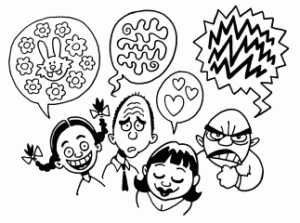
I choose words every day. When speaking, writing, requesting and deciding, I use some words and not others. You do, too.
The words we choose create meaning and mission in our lives. This became clear when a close friend said he was “still looking for a wife.” I know this guy. He will only get married when he decides to stop looking – and start finding.
Listen to the difference in these few words:
“What do you want?” or “How may I help you?”
“I didn’t mean it.” or “Please accept my apology.”
“It’s in the instruction manual.” or “Let me answer that for you.”
“We don’t have any more.” or “I can order that for you now.”
What a difference a few words can make! This is especially so when you want to improve customer experience.
In the bathroom of Le Meridien Cyberport Hotel in Hong Kong, I found a small note with a stern message. In bold letters it said:
I FORGOT: Should you need other amenities, please do not hesitate to call our Solutions Center. Press “0.”
– Sewing Kit – Nail Kit – Razor Kit
– Dental Kit – Shoe Mitt – Mouth Wash
– Hair Kit – Others
I checked my toiletries and was relieved that I did not forget. It doesn’t sound very inviting to call a “Solutions Center” and request a “dental kit.” The note did nothing to improve customer experience in my case.
One week later in the bathroom of the Crowne Plaza Hotel in Dubai, I found a small note with a gentle message that did improve customer experience:
WITH OUR COMPLIMENTS: If you require any essential toiletries, please contact reception. We will be pleased to deliver to you with our compliments: shaving cream, razor, comb, toothbrush and toothpaste, cotton wool or female sanitary products. Welcome home.
As I read the note, I felt comfortable, cared for and at ease.
What a difference a few words can make to improve customer experience!
On a boat in Hawaii, the crew was unfriendly and rude. A large sign read: “Wind and waves can tip the boat, but only you can tip the crew.” There were sixteen tourists on board. Not one left a tip.
At a coffee bar in Malaysia, I saw a box with a sign reading “Tips are encouraged,” but I saw no smiles from the staff. The tip box was empty.
On Starbucks counters worldwide, small boxes are full of coins and notes – tips for the enthusiastic team. No sign is needed: Genuine smiles and friendly service send the appropriate message to improve customer experience.
In the rooms at the Sofitel in Hanoi there is a sign: “During your stay we would be grateful if you respect our ‘no tipping’ policy. Your satisfaction is our best reward.”
What a difference a smile can make to improve customer experience.
You can also teach key words and special phrases to your customers. This will increase their sense of belonging, loyalty and connection. It can also improve customer experience.
It took months of practice, but I can now walk confidently into Starbucks and ask for “a tall, low-fat, double-shot mocha with a single pump and extra whip, not too hot.”(Which means a medium-sized drink with an extra shot of espresso, one third the usual amount of chocolate syrup, low-fat milk steamed to a slightly lower temperature than usual, plenty of whipped cream on top.)
Choose special words and phrases to communicate with colleagues and not offend your clients.
At Disney stores worldwide, good buyers are called “Guests” and potential trouble makers or shoplifters are called “Customers.” It’s very helpful when staff need to point out someone to the store manager or security guard. They simply say out loud, “A customer here needs help!” raising their first finger upwards with their thumb pointing in the direction of the potentially problematic “customer.”
When will software designers realize that “Search” is a database function, while “Find” is what people want to accomplish?
Every word has mood and meaning. Every word counts. Every word matters to improve customer experience.
Choose your words carefully when asking staff for feedback after a training session.
The evaluation form I use features just three questions, each focusing on the value, benefit and application of the new learning:
a. What did you learn today that you found most beneficial?
b. How will you apply what you have learned at work?
c. Any other comments are welcome.
I do not recommend any question that causes participants to judge the training (e.g., Not Satisfied, Somewhat Satisfied, Very Satisfied). This turns your students into critics at the last minute when they should be focusing most clearly on reviewing key points and planning their action steps.
If your participants do have praise, suggestions or complaints about the training or the speaker/trainer, they will use the “comments” section provided.
Key Learning Point To Improve Customer Experience
Every word and phrase you choose conveys mood, tone and meaning. Remember, customers and colleagues come in every possible stage of enthusiasm, anxiety, understanding and confusion. Pay attention to improve customer experience! When you are offering, asking, responding, explaining, invoicing, installing or advising, choose the words you use with care to improve customer experience.
Action Steps To Improve Customer Experience
From your customers’ point of view, which words and phrases sound positive and helpful, appreciative and respectful, inviting and secure? Which words sound cold and confusing, overly technical or even condescending? Make a list to improve customer experience.
Now review the language of your company communications to improve customer experience. Read everything aloud. Listen to the words as they are spoken. Do you hear what customers love to hear, or do you hear internal conversations, industry standards and company jargon? Listen carefully to your language and then make changes to improve customer experience.
—————————————————————————————————————————–
You may use this article in your free newsletter, website or publication providing you include this complete statement (below) with active links to the websites:
Copyright, Ron Kaufman. Used with permission. Ron Kaufman is the world’s leading educator and motivator for upgrading customer service and uplifting service culture. He is author of the bestselling “Uplifting Service” book and founder of Uplifting Service. To enjoy more customer service training and service culture articles, visit www.RonKaufman.com.
For commercial use of this article in a paid newsletter, publication, or training program, please contact us.



